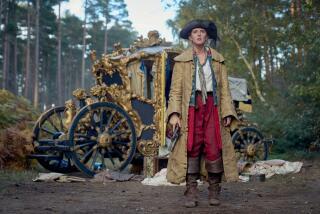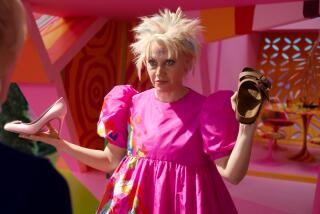‘Maleficent’ and why we love our childhood villains
She is the meanest woman ever to get her own plush toy.
Maleficent, the wicked fairy from “Sleeping Beauty” who condemns the infant Princess Aurora to die, is the protagonist of a new movie starring Angelina Jolie and an unlikely character to boast her own, $175-million, PG-rated fantasy, complete with tie-in Hot Topic fashion line and huggable, 7-inch doll (retail price: $11.99).
But this villainess — who carries on her black wings a complex history of women and power — has a surprisingly avid fan base of outsiders and eccentrics, beginning with the movie’s 38-year-old star. For Jolie, as for some others who sidestepped the princess phase, Maleficent represented a charismatic alternative to traditional, passive fairy-tale heroines.
“For little girls like me, when we didn’t have the modern Disney we have today, we had a lot of princesses that didn’t have the strength,” Jolie says. “They had a sweetness ... but not necessarily a power and a sense of self that was very strong.
“When I was little, [seeing Maleficent] was like when you look at Marlene Dietrich for the first time. She was so elegant and so strong, and seemed to be having a great time. She always seemed ... like she had a secret, like something else was going on and you couldn’t get close enough to her to know what that was, and so she remained a mystery.”
“Maleficent,” which arrives in theaters Friday, comes 55 years after Disney’s animated “Sleeping Beauty,” which presented a visually arresting but underdeveloped version of an evil mistress from fairy tales by Charles Perrault and the Brothers Grimm. The 1959 Maleficent, with her pointy horns and voluminous black and purple cape, is essentially ticked off because she wasn’t invited to a baby shower.
The new film, written by “Alice in Wonderland” screenwriter Linda Woolverton and directed by “Alice” and “Avatar” production designer Robert Stromberg, presents a more sympathetic motivation for Maleficent’s cruelty. Sharlto Copley plays King Stefan, a much more complicated man than the “good king” of the original tale; Elle Fanning is the ethereally beautiful and cursed Aurora; and 14-year-old English actress Isobelle Molloy, from the British TV series “EastEnders,” is young Maleficent.
“The story says ‘Good King Stefan,’ ” Woolverton says. “I thought, ‘Well, what’s so good about him? Maybe he isn’t so good, looking at the whole thing upside down from her point of view. Nobody has to be who they profess to be.”
Introduced in the film as an awkwardly large, nature-loving fairy child, Maleficent doesn’t seem to fit in with the other fairies, particularly a trio of teeny flibbertigibbets played by Imelda Staunton, Lesley Manville and Juno Temple. But, apart from her name, there’s little to indicate Maleficent’s dark future, until she experiences a wrenching and deeply metaphoric betrayal that hardens her.
“What I was searching for was, what on earth happened in this woman’s life that she would be so driven to curse a baby?” Woolverton says. “We had to see the human being in her. She can’t just be charging around being mean from the beginning to the end. Who cares? We might as well just do the original movie. To me it’s more interesting to show all the facets of womankind. You’re vulnerable and you have pain. Things happen to you, and you take them to heart. Things change you, but you can change back.”
A cultural shift
Movie studios on a quest for recognizable brands have plundered the stock of traditional protagonists — Disney alone already owns Luke Skywalker, Captain America and Buzz Lightyear — so it might be tempting to ascribe Maleficent’s current moment to a hero shortage.
“The skeptical view is that there’s such a lack of great material out there they’re mining it for everything they’ve got out of desperation,” says Woolverton.
But Woolverton and others see a more significant cultural shift at work, with “Maleficent” the latest iteration of a process that has been unfolding for both male and female characters for years, as the line between villain and hero has blurred in stories as varied as the revisionist “Wizard of Oz” novel and Broadway show “Wicked” and the HBO mob drama series “The Sopranos.”
“We’ve always had this tendency to project all the evil onto the barbarians and those who live in distant places and are very different from us,” says Maria Tatar, chair of the program in folklore and mythology at Harvard University. “But there has been a recognition over the last decade or so that the monsters are us, and we’d better face them.”
Like Tony Soprano, this Maleficent has the potential for redemption. Yes, she curses a baby, but that was a particularly bad day. She also uses her magic for good, to protect her world, the Moors, and to help Aurora.
“We aren’t always good,” Woolverton says. “We can be bitchy, and that’s OK too. You can be really, really bitchy, and you can also be this other thing, a beautiful, loving person. We all have moments.”
Disney has long acknowledged the appeal of its own darker characters. Though they represent a smaller part of the merchandising pie than the company’s juggernaut Disney Princess franchise, the Disney Villains brand includes toys and books of the Evil Queen from “Snow White,” Cruella de Vil (“101 Dalmatians”), Ursula (“The Little Mermaid”), Scar (“The Lion King”) and Captain Hook “Peter Pan.”
Mary McGrath, 7, of Metuchen, N.J., picked out her first Maleficent doll at 18 months. Now she has five Maleficents as well as a horned headpiece, several picture books and a necklace. She’s met the Maleficent at Disney World in Orlando, Fla., some 20 times; the character gave her a raven feather on one visit and a handwritten letter on another.
“From the beginning it was that Maleficent was different,” says Mary’s mother, Amy McGrath. “Everybody was into the princess stuff. You go into the Disney store and you see all the pastel dresses, and I think Mary just liked the contrast between the princesses and this character in black. When people bring it up and say, ‘Oh, you’re into that,’ she’s proud of it.”
Maleficent is the first of the Disney Villains to get her own, theatrically released movie, and the studio has not announced plans for any others. But after the success of last year’s Disney Animation movie “Frozen,” which morphed the fairy tale of the Snow Queen into a story of sisterly love, Disney seems intent on chiseling away at the princess ideal the company was founded upon.
“Disney is smart,” Woolverton says. “If they don’t evolve they’ll become irrelevant.”
The movie, which is expected to open at $60 million amid particularly strong interest from female audiences, will face tough competition at the summer box office from an X-Men sequel already in theaters and an animated sequel (“How to Train Your Dragon 2”) and teen tear-jerker (“The Fault in Our Stars”) soon to come.
Disney needs “Maleficent” to take off domestically and abroad to earn back its investment in the effects-heavy film. Maleficent’s fans aren’t so sure.
“A bunch of my friends who don’t like Maleficent a lot are going to go see the movie,” Mary McGrath says. “I’m interested in seeing it, but I’m kind of not happy that they’re making it, because then all the lines [at Disney World] are going to be long to see her.”
More to Read
Only good movies
Get the Indie Focus newsletter, Mark Olsen's weekly guide to the world of cinema.
You may occasionally receive promotional content from the Los Angeles Times.







